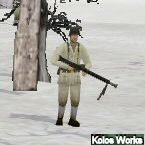ravinhood
Posts: 3891
Joined: 10/23/2003
Status: offline

|
Oh he's got you there, what about VASSEL? ;)
But, Vassel doesn't use an AI does it? (darn I thought we had him) hehe or you rather, you guys are talking WAYYYY over my head now. I just come up with ideas, you're the ones that are suppose to be smart enough to implement them. ;)
Also here is another idea I have. An AI DATA CACHE, this is a file that increases in size as the AI plays the human which sort of does "learn" how the human plays and counter acts it by doing something new.
This idea is more for games like Warlords or Civilization or Spartan not so much a hex based wargame, but, might be able to be coded in some way to use there as well.
For instance AI initial attack is toward a city, this city is well defended, put that in the AI cache.
With that in the cache it's next outing might goto another city or another "objective hex" and record the outcome of that situation.
It could record battle odds and thus not send more weak units or stacks to the same place it just lost by having weak units or stacks. Perhaps placing a marker on the humans units, it knows its composition now, why not record it (that's what we do) and keep an eye on it and go after it with an increased odds stack instead of sending another puny weak unit or stack out to engage it?
It could record the battle odds and increase them and then go back to that city it was beating its head upon with double or triple power.
Everything on the map is not the most important thing, thus "unseen objective hexes" could be plotted within the makeup of the game to give the AI more cordination and organization about where to move, and with what force and where to defend and with what force.
I've seen some simularities of this in Slitherines Spartan, but, it doesn't learn, thus it will send one stack after another to the same city over and over and that's where it loses, because I will just sneak a stack behind it and start wiping out it's inner or rear cities and it never responds to this quick enough in the end. It's still a great AI, but, if it gives me time to setup that defense in that one city, then I have the advantage, I don't always have that "time" though, so I've lost several games. ;)
Something else I brought up before was to cut all wargame maps down into 64 squares/hexes each and the AI concerns itself with the first 64 squares, then looks at the flanking 64 squares for 2ndary maneuvering. This like chess, since they keep saying chess is so easy to program the AI. If the AI doesn't have to monitor the entire board at once, looks like to me if you bring the scope of vision down to just what is in front of it and to it's flanks with only 64 squares in each to observe it would be easier for it to make a good decision. It always seems (especially with HPS games) the bigger the map, the worse the AI gets. This is pratically true though for all wargame AI's. There's no use calculating how to take Los Angeles when you haven't even taken Washington yet I don't think. And I've seen games where the AI in fact does this type of maneuver, trying to take something on the opposite end of the map when its got clear and untaken objectives right in front of it.
Next problem: Understanding defense. Understanding the Objective is to WIN. Combat Mission would be the number one game of all time, but, the AI is stupid near the end of the scenaro. It's on a defensive mission and it breaks out of it's foxholes near the end and does this parade of death towards my well protected line of attack. It's practically suicidal. It does the same thing in meeting engagements when IT'S AHEAD, it would win the stupid battle if it would just hold it's ground, but, those "objective hexes" have been programmed to be too important and it breaks its line and it's defense trying to take the sole and only objective hex I occupy and thus my men slauther it and I end up winning. That's just sad, really sad. lol
< Message edited by ravinhood -- 11/29/2005 9:22:06 AM >
|
 Printable Version
Printable Version













 New Messages
New Messages No New Messages
No New Messages Hot Topic w/ New Messages
Hot Topic w/ New Messages Hot Topic w/o New Messages
Hot Topic w/o New Messages Locked w/ New Messages
Locked w/ New Messages Locked w/o New Messages
Locked w/o New Messages Post New Thread
Post New Thread